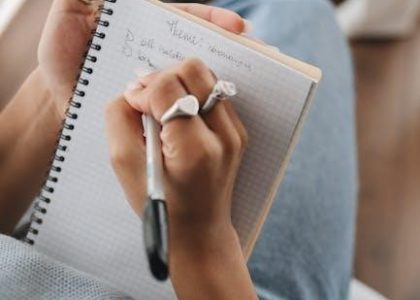Ties are a timeless symbol of elegance and refinement, offering a simple yet powerful way to elevate any outfit. They signify confidence, respect, and personal style.
1.1 Importance of Ties in Fashion
Ties are a cornerstone of formal fashion, serving as a powerful accessory to elevate outfits and convey confidence. A well-tied tie enhances professionalism and leaves a lasting impression. It complements suits, adding a touch of elegance. Ties also express personal style, offering endless options in patterns, colors, and designs. A quality tie retains its shape, avoiding a sloppy look. Whether for weddings, interviews, or black-tie events, ties are a symbol of respect and refinement, making them indispensable in formal wardrobes. They complete a polished look, ensuring the wearer stands out with poise and sophistication.
1.2 Brief Overview of Tie Types
Ties come in various styles to suit different preferences and occasions. The necktie is the most common, available in wide or slim widths. Bow ties are popular for formal events like black-tie gatherings. Skinny ties are trendy for a modern look, while clip-on ties offer convenience. Pocket squares complement ties, adding a coordinated touch. Tie bars and dimples enhance the overall appearance, ensuring a polished finish. Each type serves a unique purpose, allowing individuals to express their style and adapt to different settings with ease and sophistication.
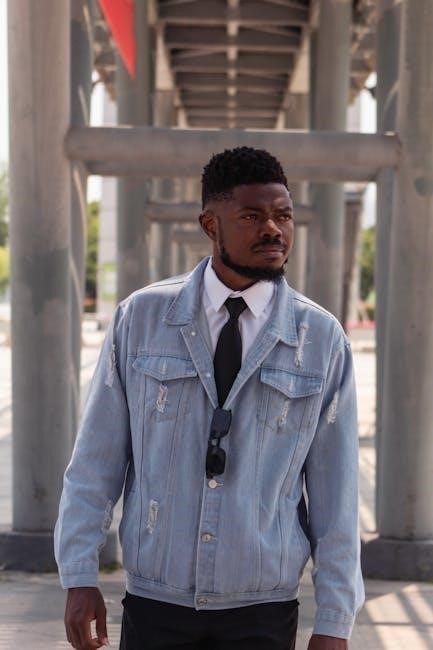
History of Ties
Ties originated in 17th-century Europe, evolving from functional scarves to fashionable accessories. Over centuries, they transformed into symbols of elegance and sophistication, becoming a staple in formal attire.
2.1 Origins in 17th-Century Europe
The modern tie traces its origins to 17th-century Europe, where Croatian mercenaries wore distinctive scarves as part of their uniform. These scarves, known as “cravats,” were adopted by French aristocrats and became a symbol of elegance. Over time, the cravat evolved into various forms, such as the steinkirk and jabot, each reflecting the fashion of its era. By the 19th century, the cravat had transformed into the necktie, a staple in men’s formal attire. This evolution marked the beginning of the tie’s enduring role in fashion and its association with refinement and sophistication.
2.2 Evolution Over the Centuries
Over the centuries, ties have undergone significant transformations, reflecting cultural and societal changes. By the 19th century, the cravat evolved into the bow tie and the long necktie, with the latter becoming a staple in men’s fashion. The 20th century saw the rise of the Windsor knot, popularized by the Duke of Windsor, and the Four-in-Hand knot, a simpler style for everyday wear. Silk became the preferred fabric, and patterns like stripes and dots emerged. The 1960s introduced bold colors and wider ties, while the 1980s favored slim, minimalist designs. Today, ties remain a symbol of sophistication, adapting to modern tastes while honoring their historical roots.

Basics of Tying a Tie
Drape the tie around your neck with the thicker side on your left. Cross it over the slimmer side, loop it behind, and bring it up. Adjust and smooth wrinkles for a polished look.
3.1 Essential Steps for Beginners
Start by draping the tie around your neck with the thicker side on your left. Cross the longer side over the shorter one, then loop it behind. Bring the longer side up and through the neck loop from below. You’ll see the knot start to form. Pass the longer side behind the shorter side and bring it up again, tucking it into your collar. Adjust the tie so it’s centered and the knot sits snugly under your collar. Use a mirror to guide you and practice regularly to master the technique. This method ensures a neat and professional finish for any occasion.
3.2 Choosing the Right Knot for Your Collar
Matching your tie knot to your shirt collar is key for a polished look. For point-collar shirts, opt for slim knots like the Four-in-Hand. Spread-collar shirts pair well with fuller knots such as the Windsor or Half-Windsor, as they fill the space. Cutaway collars are best with asymmetrical knots like the Eldredge or Trinity, which add visual interest. Consider your face shape too—wider faces suit larger knots, while narrower faces look better with smaller ones. The occasion also matters; formal events call for classic knots, while creative knots work for casual settings. Experiment to find the perfect balance for your style and wardrobe.
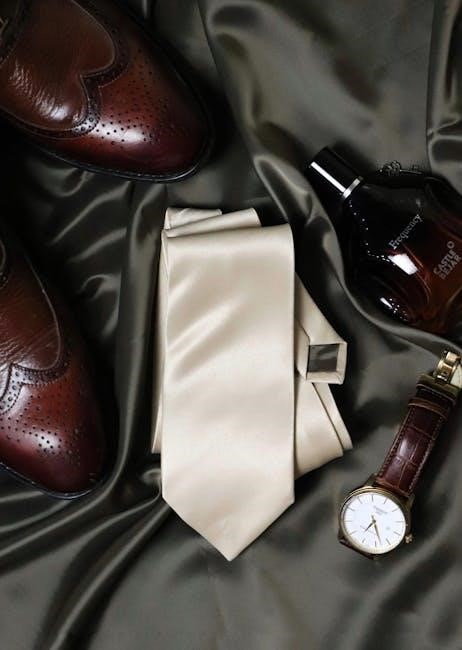
Different Knots
Tie knots vary in complexity and style, offering options for every occasion. From classic Windsor to trendy Eldredge, each knot serves a unique purpose and enhances your look.
4.1 Windsor Knot
The Windsor Knot, also known as the Full Windsor, is a thick and triangular tie knot, ideal for spread-collar shirts. It creates a bold, professional appearance, perfect for formal events and job interviews. To tie it, start by facing a mirror and looping the tie around your neck with the wide end on your left. Cross the wide end over the narrow end, then behind and up, forming a loop. Bring it down through the neck loop and tighten gently for a symmetrical finish. This knot is versatile and works well with both solid-colored and patterned ties, ensuring a sharp, polished look every time.
4.2 Four-in-Hand Knot
The Four-in-Hand Knot is the simplest and most common tie knot, perfect for beginners. It creates a slim, straightforward shape that works well with standard collar shirts. To tie it, drape the tie around your neck with the wide end on your left. Cross the wide end over the narrow end, then loop it behind and bring it up through the neck loop. Pass it behind the narrow end and through the loop again, then tighten gently. This knot is versatile and suitable for both casual and formal occasions, though it pairs best with solid-colored ties to highlight its clean design.
4.3 Eldredge Knot
The Eldredge Knot is an intricate and attention-grabbing tie knot that adds a touch of sophistication to any outfit. It is perfect for those who want to make a bold statement. To tie it, start by flipping up your shirt collar and draping the tie around your neck with the wide end on your right. Cross the wide end over the narrow end, then loop it under and bring it up through the neck loop. Pass it behind the narrow end and through the loop again, adjusting as needed. This knot works best with solid-colored ties, allowing its unique pattern to stand out. It’s a bit challenging but worth the effort for its striking appearance.
4.4 Trinity Knot
The Trinity Knot is a distinctive and stylish tie knot that features three layers, creating a triangular shape. It is a versatile option suitable for both formal and semi-formal occasions. To tie it, start with the wide end of the tie on your left side. Cross it over the narrow end, then loop it under and bring it up through the neck loop. Repeat this process to create the three layers, adjusting the knot as needed for symmetry. The Trinity Knot works well with spread-collar shirts and is ideal for making a statement at events like weddings or business meetings. Its unique design adds a touch of sophistication to any outfit.
4.5 Bow Tie Knot
The bow tie knot is a classic choice for formal events like black-tie weddings and galas. It consists of two symmetrical loops, creating an elegant bow shape. To tie it, start by draping the tie around your neck with one side longer than the other. Cross the longer side over the shorter side, then loop it behind and bring it up through the neck loop. Fold both ends into bow shapes, ensuring they are even. The bow tie is typically paired with a wing-tip collar shirt and is a hallmark of sophistication. Its timeless appeal makes it a staple for formal attire, offering a refined look that sets the wearer apart at special occasions.
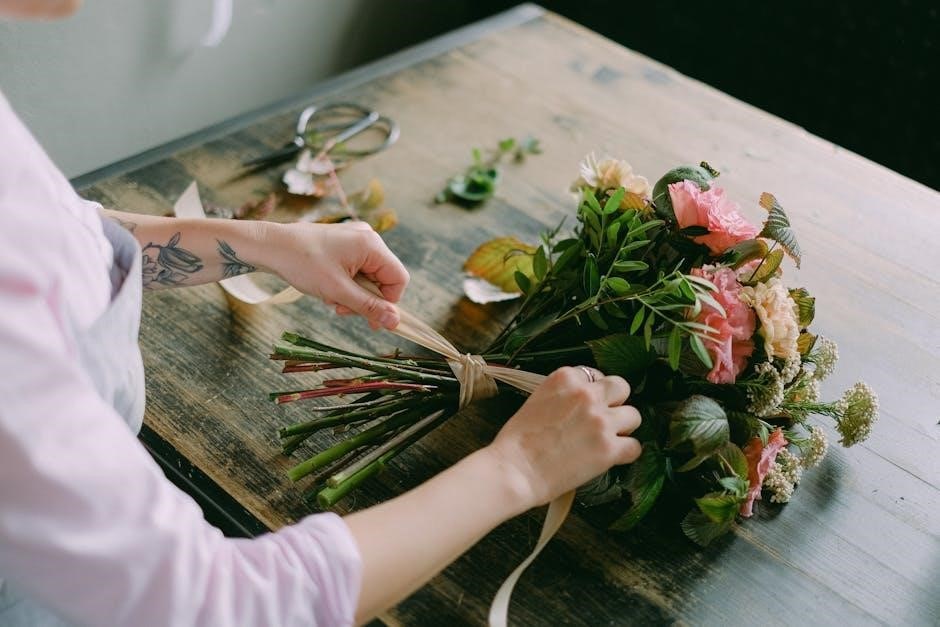
Choosing the Right Tie
Selecting the ideal tie involves balancing length, width, and material. Opt for ties that complement your face shape, shirt color, and suit pattern, ensuring a polished look for any occasion.
5.1 Selecting the Correct Length and Width
The perfect tie length should reach your belt buckle, typically between 57 to 60 inches for most men. Width depends on your body type and current trends. Slim ties suit narrower collars, while wider ties complement broader shoulders. Ensure the tie is proportional to your shirt and suit for a balanced look. Properly fitted ties avoid overwhelming or appearing too small, creating a polished and professional appearance.
5.2 Matching Ties with Shirts and Suits
Matching ties with shirts and suits is an art that enhances your overall appearance. Start by coordinating the tie’s color with your shirt, ensuring complementary tones. Solid-colored ties offer versatility, pairing well with patterned shirts, while patterned ties should subtly align with the shirt’s design. For suits, opt for ties that harmonize with the suit’s fabric and color, avoiding clashing hues. Earthy tones like navy, charcoal, and gray are safe choices, while bolder colors can add personality. Texture and pattern balance are key—smooth ties with textured suits or patterned ties with plain suits. Always aim for a cohesive look that reflects your personal style.
5.3 Occasion-Specific Ties
Choosing the right tie for an event is crucial, as it reflects the occasion’s formality and your respect for it. For black-tie events, opt for a bow tie in silk or satin, ensuring it matches the suit’s lapels. Weddings and formal galas call for elegant, subtle patterns like stripes or polka dots. Business meetings require classic, professional styles, such as navy or charcoal ties with minimal designs. Casual gatherings allow for bold colors and playful patterns, adding a personal touch. Consider the dress code and atmosphere to select a tie that complements the setting, ensuring you make a stylish and appropriate impression.

Tips for Wearing Ties
Ensure the tie is centered, with its tip reaching your belt buckle. Adjust the knot to fit snugly under your collar for a polished, professional appearance.
6.1 Ensuring the Tie is Centered
Ensuring the tie is centered is crucial for a polished look. Start by draping the tie symmetrically around your neck, with the wider end on your left and narrower on your right. After tying the knot, adjust the tie so it sits evenly under your collar. Tuck the tie into your shirt to keep it in place and prevent it from shifting. For added security, use a tie bar or clip to fasten it to your shirt. A centered tie creates a balanced, professional appearance, making it a fundamental aspect of proper tie etiquette. This step ensures your outfit looks tidy and well-coordinated.
6.2 Adjusting the Knot for a Perfect Fit
Adjusting the knot ensures both comfort and a polished appearance. After tying the knot, gently tug on both ends of the tie to tighten it around your neck. Use a mirror to guide you, ensuring the knot sits snugly under your collar. For a perfect fit, the tie should feel secure but not constricting. Smooth the fabric to eliminate wrinkles, and ensure the knot is centered. If the tie feels too tight, loosen it slightly by pulling down on the knot. Practice makes perfect, and proper adjustment enhances the overall look of your outfit, making it both stylish and comfortable. This step is essential for a refined finish.
Care and Maintenance
Proper care extends a tie’s life. Avoid stains, store ties flat or hung, and use a steamer instead of ironing to maintain shape and fabric integrity.
7.1 Cleaning and Storing Ties
Proper cleaning and storage are essential for maintaining the quality and longevity of your ties. For minor stains, use a clean, damp cloth to gently blot the area. Avoid rubbing, as this can damage the fabric. For tougher stains, consider using a baby wipe or a silk-friendly cleaner. Never iron a tie, as heat can ruin the material. Store ties in a cool, dry place, either hanging on a tie rack or rolled up in a drawer. Avoid creasing by not folding ties for extended periods. Regularly cleaning and storing ties properly ensures they remain vibrant and well-preserved for years.
7.2 Avoiding Common Damage
To prevent damage, avoid exposing ties to direct sunlight, as this can cause fading. Never tighten the knot excessively, as it may stretch or tear the fabric. Avoid eating or drinking while wearing a tie to prevent stubborn stains. When removing a tie, gently pull it down instead of yanking it, which can cause wrinkles or damage the lining. Additionally, steer clear of using harsh chemicals or abrasive cleaners, as they can harm the material. By taking these precautions, you can keep your ties looking sharp and extend their lifespan, ensuring they remain a stylish accessory for years to come.
Tie Accessories
Tie accessories, like bars, clips, and dimples, enhance both functionality and style. They secure the tie in place, ensuring a polished look and preventing wardrobe mishaps. Essential for perfection.
8.1 Tie Bars and Clips
Tie bars and clips are essential accessories that add both functionality and style to your outfit. A tie bar, also known as a tie clip, is a small metal or plastic device that securely fastens the tie to the shirt, preventing it from shifting or flapping. Clips are particularly useful for slim ties, ensuring they stay in place. When choosing a tie bar, consider its width—it should never be wider than the tie itself. Properly using a tie bar enhances the overall neatness of your appearance, making it a must-have accessory for formal occasions. They come in various designs, from simple to decorative, allowing for personal expression while maintaining professionalism. Additionally, tie bars can be a subtle way to add a touch of personality to your ensemble without drawing attention away from the tie or suit. By keeping the tie aligned and centered, tie bars contribute to a polished, put-together look that is essential for making a strong impression. Whether you’re attending a business meeting, a wedding, or a formal event, incorporating a tie bar or clip into your attire is a practical and stylish choice.
8.2 The Role of Tie Dimples
Tie dimples are small indentations at the center of a tie knot, adding a touch of character and sophistication. They serve both aesthetic and functional purposes, creating a subtle texture that enhances the tie’s visual appeal. Dimples also prevent the tie from lying too flat, giving it a more dynamic and polished look. A well-executed dimple is often seen as a hallmark of a stylishly tied knot. While not mandatory, dimples can elevate the overall appearance of the tie, making it more distinctive and refined. They are a small detail that speaks volumes about attention to style and craftsmanship.
Black Tie Guide
Black tie events are the epitome of formality, traditionally requiring a dinner jacket and bow tie; They embody elegance and sophistication for high-profile occasions.
9.1 Understanding Black Tie Events
Black tie events are the ultimate formal occasions, typically held in the evening. They require meticulous attention to detail in attire, with men expected to wear a tuxedo, complete with a bow tie, while women opt for elegant evening gowns. These events, such as galas, award ceremonies, or high-end dinners, demand a sophisticated look. The bow tie is a hallmark, symbolizing refinement and tradition; Proper grooming and accessories, like cufflinks and a pocket square, complete the look. Understanding the nuances ensures respect for the event’s grandeur and leaves a lasting impression of style and poise.
9.2 Appropriate Attire for Black Tie Occasions
For men, black tie attire revolves around a tuxedo, typically in black or midnight blue, paired with a white dress shirt and a bow tie. The tuxedo jacket, often satin or silk-lined, should fit impeccably. Formal trousers with a strip of satin or braid complement the jacket. Black patent leather shoes are essential, while cufflinks and a simple watch add elegance. For women, floor-length evening gowns in luxurious fabrics are customary, often accessorized with jewelry and clutch bags. The ensemble must exude sophistication, ensuring every detail aligns with the event’s formality, creating a cohesive and polished appearance that honors the occasion’s prestige.
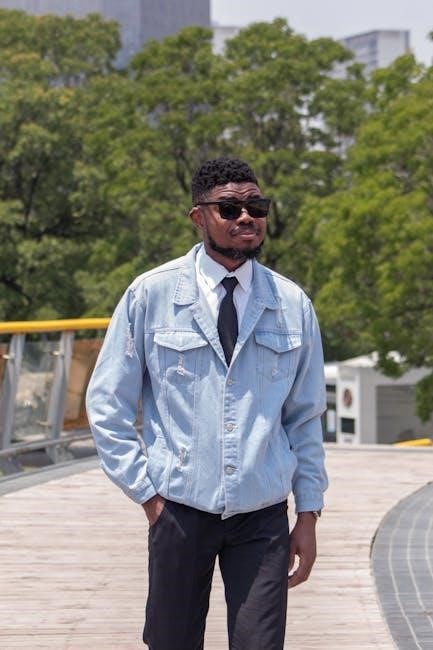
Bow Tie vs. Necktie Debate
Bow ties and neckties each offer unique charm, catering to different occasions and personalities. Bow ties add whimsy, perfect for formal events, while neckties convey professionalism and versatility, suiting everyday wear and business settings.
10.1 When to Choose a Bow Tie
A bow tie is ideal for formal events like black-tie weddings, galas, or dinners, where it adds a touch of sophistication and uniqueness to your outfit. It’s also perfect for showcasing personality through bold patterns or colors. For less formal settings, such as themed parties or artistic gatherings, a bow tie can make a stylish statement. However, it’s best avoided in traditional business environments where neckties are more appropriate. Mastering the bow tie knot and pairing it with a well-tailored suit ensures a polished and memorable look. It’s a great way to stand out while maintaining elegance.
10.2 When to Opt for a Necktie
A necktie is the go-to choice for business meetings, job interviews, and formal events like conferences or weddings. It conveys professionalism and adaptability, making it ideal for everyday office wear or semi-formal occasions. For black-tie events, however, a bow tie is typically preferred. Neckties are versatile and can be paired with various shirts and suits to create a polished look. Ensure the tie is centered, the knot fits snugly under the collar, and the length aligns with your belt buckle. Matching the tie’s pattern and color with your outfit ensures a cohesive and stylish appearance, making it a reliable choice for most formal and professional settings.
Pocket Square Guide
A pocket square complements a tie, adding a touch of elegance. Coordination with ties, folding techniques, and matching colors/patterns are key to enhancing your outfit—
11.1 Coordinating Pocket Squares with Ties
Coordinating pocket squares with ties enhances your outfit’s harmony. Opt for complementary colors or subtle patterns that echo the tie’s design without overwhelming it. For solid ties, patterned squares add depth; for patterned ties, simpler squares balance the look. Ensure the pocket square’s fabric aligns with the tie’s material for a polished appearance. Folding techniques, such as the classic straight or puff fold, also play a role in maintaining style cohesion. Remember, the pocket square should complement, not overpower, the tie, creating a seamless blend of color and texture that elevates your overall ensemble.
11.2 Popular Folding Techniques
Mastering pocket square folds can elevate your style effortlessly. The Straight Fold is sleek and minimalist, suitable for formal events. The Puff Fold adds volume and texture, ideal for patterned ties. The Winged Fold creates a subtle peak, complementing slim collars, while the Accordion Fold offers a modern, layered look. Each technique enhances your outfit’s sophistication when paired with a well-coordinated tie. Experiment with folds to find what suits your style and occasion, ensuring a polished, cohesive appearance that reflects attention to detail and refinement.
Work Dress Code Guide
Navigating office dress codes can be challenging, but understanding the basics helps build a professional wardrobe. This guide offers tips to dress appropriately for work settings.
12.1 Navigating Office Dress Codes
Understanding and adhering to office dress codes is essential for making a professional impression. Most workplaces follow either formal, business casual, or smart casual attire. Formal settings typically require suits, ties, and dresses, while business casual allows for slacks, blouses, and dress shirts. Smart casual is more relaxed but still polished. Pay attention to company culture, as some offices may permit jeans or creative attire. Building a versatile wardrobe with tailored pieces ensures you’re prepared for any dress code. Neutral colors, quality fabrics, and proper fit are key. Accessories like ties, belts, and scarves can enhance your look while staying within guidelines.
12.2 Building a Work-Ready Wardrobe
Constructing a work-ready wardrobe involves investing in timeless, versatile pieces that align with your office dress code. Start with classic suits in neutral tones like navy, black, and charcoal, paired with crisp white dress shirts. Add variety with subtle patterned shirts and complementary ties. Ensure trousers and blazers fit well, as tailoring enhances professionalism. Incorporate high-quality leather accessories, such as belts and shoes, for a polished look. For women, tailored blouses, pencil skirts, and slacks are essentials. Mix and match these basics to create multiple outfits, ensuring each piece can transition seamlessly from day to night. Quality over quantity is key for a cohesive, professional wardrobe.




